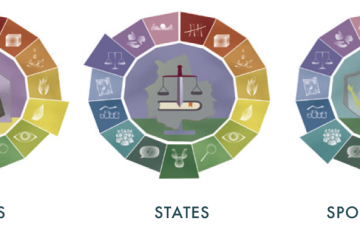Today I want to share a fascinating story of Christian celebration of biodiversity. In the highlands of Ethiopia, circular church buildings are surrounded by patches of the forest that once covered the landscape. Varying from less than a hectare up to thousands, these forests host a wide diversity of both animals and plants, and include individual trees hundreds of years old. But as farming has intensified, the church forests have been shrinking and their regeneration is threatened by cattle grazing. Now a project is underway to build stone walls around these forests to prevent further encroachment – and in some cases the forest is now expanding. A very rich and moving account of this situation is given by Fred Bahnson at the following link – complete with aerial video footage:
https://emergencemagazine.org/story/the-church-forests-of-ethiopia/
I wanted to post this link here as an inspiring example of Christian scholarship in action. The Ethiopian Orthodox church life depicted in that article seems a long way from the expressions of faith that I and probably most readers of this blog are familiar with. Yet it appears to be a tradition that’s as deeply biblical as mine, and with deeper roots into the specifics of place and the lives of non-human creatures: this world that God loved so much as to send his Son to share with us the life of the age to come.
Looking for an opportunity to apply these ideas closer to home, my mind turns to the many beautiful protected green spaces that are accessible to a large proportion of the UK population – not forgetting the peaceful green churchyards in which many Anglican church buildings are located. But a greater concern is preoccupying me just now. As lockdown measures start to be lifted and we begin to regain the freedom to meet friends and family, to travel more widely and to worship together in church buildings, will we rediscover and enlarge our appreciation for the specifics of places – that hedge, this reservoir, yonder hill, my churchyard – and of plants, animals and their diversity? Trees are creatures that we can visit and revisit, and we needn’t be students of forest ecology to appreciate that. Trees also feature prominently in the Bible, including individual specimens from the terebinth trees at Mamre (Gen 13:18) to the fig tree under which Nathanael sat (John 1:48); in fact I think we’d find that a tree is present at most key points in salvation history. But will we take the emergence from lockdown as an opportunity to engage our faith anew with the specifics of God’s creation? Not just people, but trees and places too?
I’d like to know what you think. Let’s celebrate the recovery of Ethiopian church forests – and can we learn from it too?
- Philosophy in full colour - October 21, 2025
- Flowers not flavours in AI: How large language models resonate with the beauty of creation - May 19, 2025
- Artificial thinking? - April 2, 2025


